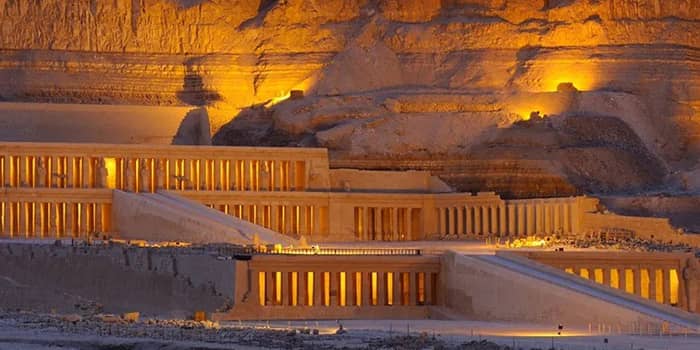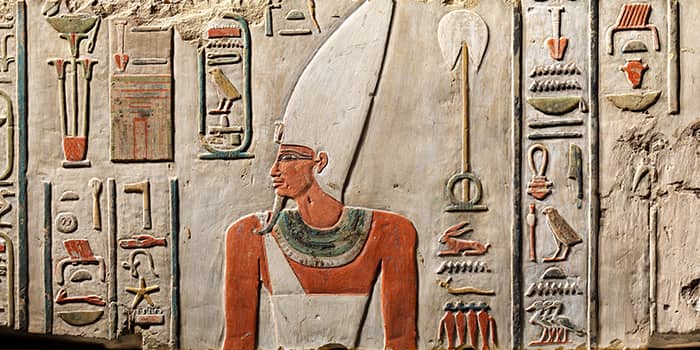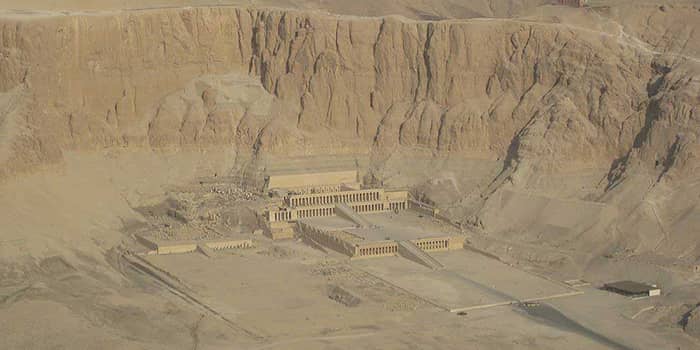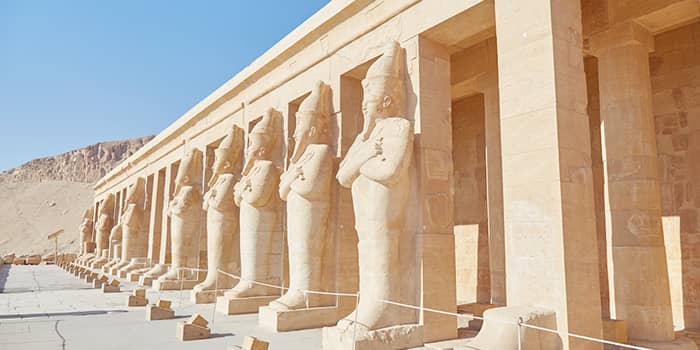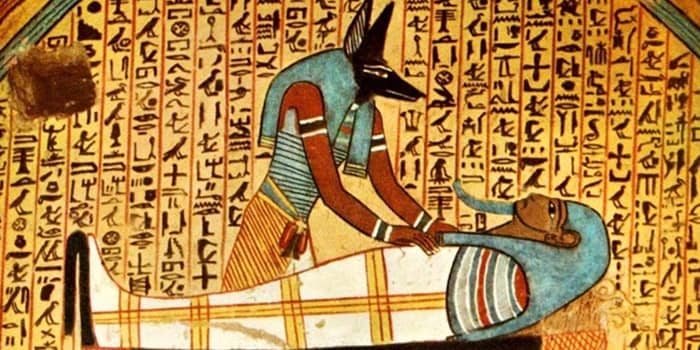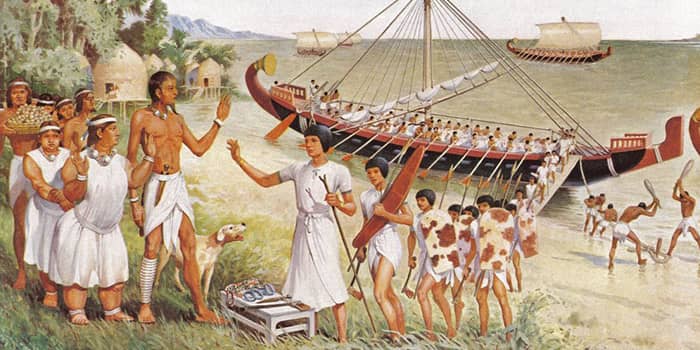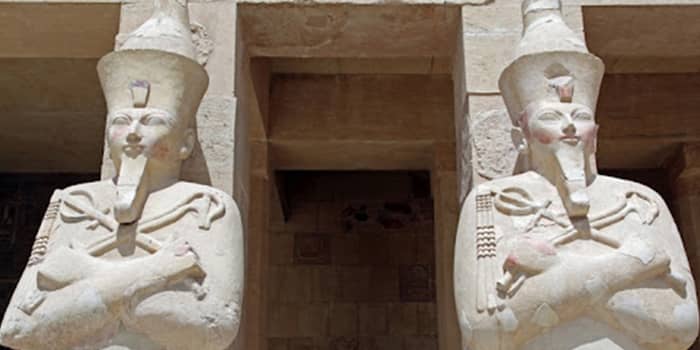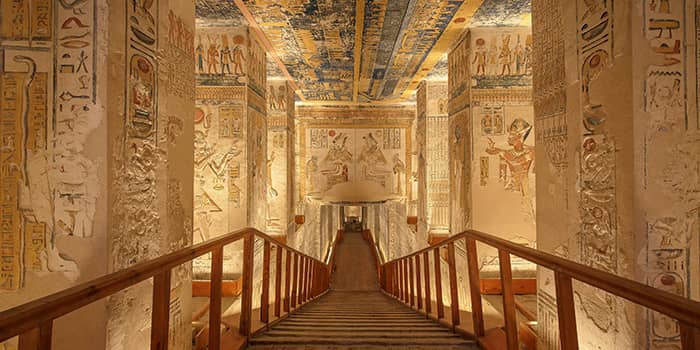When Was The MortuaryTemple of Hatshepsut Built?
The temple of Hatshepsut was known in ancient Egypt by "Djeser-Djeseru," which means "Holy of Holies." It was built during the 18th dynasty in ancient Egypt, in the New Kingdom. It lies near the mortuary temple of Mentuhotep II of the Middle Kingdom, which the temple of Hatshepsut was modeled after.
Where is The Mortuary Temple Of Hatshepsut?
The Mortuary Temple of Hatshepsut is located at an exceptional location in Upper Egypt, at the west bank of Luxor. It is located at the foot of the cliff of Deir El-Bahri, well situated to escape any rock slides from the cliff. Deir El-Bahri is also the location of the temple of Mentohotep II.
During Christianity in Egypt, the temple of Queen Hatshepsut was used as a monastery called the "Northern Monastery," which is translated in Arabic to Deir El-Bahri, the area's current name.
Who Was The Artist of The Mortuary Temple of Hatshepsut?
Sennmut was the architect of this temple, besides being many other things to the Queen. He modeled the mortuary temple of Hatshepsut after that of Mentohotep II, a Theban Prince who founded the 11th dynasty in Egypt, and initiated the Middle Kingdom. Mentuhotep II was the first to make both the temple and the tomb in one place.
What makes the Mortuary Temple of Hatshepsut more special than Mentuhotep's?
Even though Hatshepsut's temple was modeled after Mentuhotep's, they are both significantly different. The temple of Hatshepsut was designed by Sennmut to be built on a much larger scale. It was actually a turning point in Egyptian architecture and the closest they got to classical architecture.
Why Did Hatshepsut build the Mortuary Temple Of Hatshepsut?
Queen Hatshepsut was the daughter of Thutmose I, she married her brother Thutmose II, but she gave birth only to a daughter; she didn't have any sons. When her husband Thutmose II died, he had a son from another woman but he was just a kid at that time. Hatshepsut acted as a regent for her step-son Thutmose III, during that time she claimed to be the daughter of the God Amen, who the temple was built in dedication to.
During her seventh year of regency, she crowned herself as a Pharaoh of Egypt, breaking the traditions of that time. The Queen wanted to elevate her public image as a Pharaoh and immortalize her name, so she ordered the construction of this enormous temple that remains one of the most impressive structures ever.
What madeThe Mortuary Temple of Hatshepsut Famous?
The Mortuary Temple of Hatshepsut is famous for its long ramp; like most Egyptian temples, it has pylons, courts, hypostyle, sun court, chapel, and sanctuary of Amen. The temple had a lengthy colonnaded terrace and a centralized burial chamber, making it significantly different from that of Mentuhotep's.
Temples of Anubis and Hathor
At the end of the second level, you'll find two chapels, the one on the north side is dedicated to the God Anubis. It was common to dedicate parts of mortuary temples to him as he was the god responsible for leading the soul from the tomb to the afterlife. In the south, you'll find the temple of Hathor, a female Goddess whom Hatshepsut had a strong relationship with as a woman in a position of power.
Birth of a divine female Pharaoh
As you go to the ramp leading to the second level, you'll find on the right side the Birth colonnade, the reliefs on the walls recite the tale of the divine birth of a female Pharaoh as a daughter of Amen. She also made a sanctuary dedicated to the God Amen in her temple in another colonnade lined with statues.
Trade to Punt, land of the Gods
On the left, you'll see the Punt Colonnade. Punt was a mysterious "land of the Gods" known at the early dynastic period in Egypt, but it was forgotten or maybe just had been neglected by the Kings. Queen Hatshepsut made expeditions to the land of Punt; it was something she was most proud of and considered legendary; it was recited on the reliefs of her temple. It was the first documentation of a trade expedition recorded and discovered in ancient Egypt.
Why was Hatshepsut's name was Destroyed?
As Hatshepsut was a regent of her step-son Thutmose III due to his young age, she crowned herself as a Pharaoh. What do you think happened when he came to age to be crowned?
We can't really know what happened, but the last we heard about Hatshepsut was after the battle of Megiddo that was led by Thutmose III. After this point, Hatshepsut's name was destroyed, any public image of her was destroyed; Hatshepsut was erased from the public's eyes.
Why Hatshepsut wasn’t known for a long time?
It seemed like Thutmose III wanted to erase any evidence of her reign that probably happened after her death, but we can't really know why as there was no sign of enmity between them. It even seemed that he didn't have any ill intentions toward her as he left most of her temple untouched, not to cause her any harm in the afterlife.
The temple of Hatshepsut was once the house of two statues of Osiris, with the face of Hatshepsut, an avenue of
Sphinx, and many sculptures of the Queen in different positions…all destroyed.
How did we know about Hatshepsut?
Queen Hatshepsut that is now known to the entire world and a significant figure from Egypt's ancient history, wasn't actually known till recently. As we didn't know the hieroglyphs until discovering the Rosetta stone, we discovered the name of the Queen who made history on the Egyptian lands. But we still don't know her full story.
During an expedition in the early 19th century, some disposed wreckage of Hatshepsut statues and monuments that were found near her temple at Deir El-Bahri. Of course, the statues were broken, the archeologists tried bringing them to the light to know the story of the great Queen who once ruled Egypt, Hatshepsut.
When Did Hatshepsut Die?
We don't know when or how Queen Hatshepsut died, but she probably died in her fifties; her tomb wasn't found at her mortuary temple but nearby at the
Valley of the Kings, at the West bank of Luxor. But the tomb of her architect and might be lover, Sennmut, is at the temple of Hatshepsut at the second courtyard, to the right of the ramp leading to the third level.
The Mortuary Temple of Queen Hatshepsut is a must-visit during your tour in Egypt; it is located at the West bank of Luxor, where you can also visit the Valley of the Kings and the two
Colossi of Memnon.

